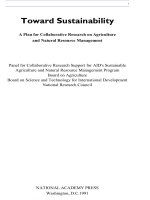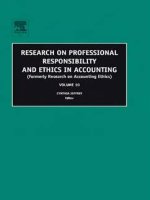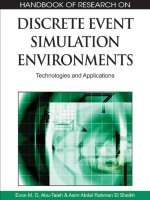Research on activated carbon preparation from macadamia shells using koh activating agent applied for methylene blue treatment
Bạn đang xem bản rút gọn của tài liệu. Xem và tải ngay bản đầy đủ của tài liệu tại đây (517.21 KB, 8 trang )
Đao Minh Trung...
Research on activated carbon preparation from...
RESEARCH ON ACTIVATED CARBON PREPARATION FROM
MACADAMIA SHELLS USING KOH ACTIVATING AGENT
APPLIED FOR METHYLENE BLUE TREATMENT
Dao Minh Trung1, Nguyen Xuan Du2, Nguyen Duc Dat Duc3 ,
Nguyen Thanh Quang1, Nguyen Vo Chau Ngan4
1
Thu Dau Mot Unniversity, 2Sai Gon University
3
Ho Chi Minh City University of Food Industry; 4Can Tho University
ARTICLE INFO
Article history:
Received May. 8.2018, Accepted Dec. 29.2018.
Contact:
Abstract
Research on bio-activated carbon wastewater treatment material prepared from Macadamia
shells using KOH activating agent at the rate of 1KOH: 1 piece of activated carbon is carried out
through influencing factors of temperature and time. The research result of Methylene blue (MB)
absorption ability at respectively optimal temperature and time of 200oC and 60 minutes of
activated carbon shows that 1g of activated carbon will absorb 91,50mg of Methylene Blue. The
result shows that the color treating efficiency of the Methylene Blue (MB) is 83,41% corresponding
to the color level reduced from 349.67 Pt-Co to 58 Pt-Co. Research result shows that bioactive
carbon prepared from Macadamia shells and activated from KOH can treat color in dyeing textile
wastewater.
Keywords: activated carbon, Macadamia shells, Methylene Blue color absorption
INTRODUCTION
Activated carbon is known to be a highly absorbent material and is used in many fields
including water treatment (Samorn Hirunpraditkoon et al., 2011; Tzong-Horng, 2009). The
absorption ability of activated carbon is influenced by many factors such as structural
characteristics, surface functional group (Yan-Juan et al., 2014), surface area, ash content,...
(Kwagher & Ibrahim, 2013). In fact, activated carbon is made from two main sources of coal and
agricultural residues including coconut shell charcoal (Kobya, 2004), rice husk (Awwad et al.,
2010) and bamboo charcoal (Wang et al., 2008).
In Vietnam, in recent years, Macadamia have been grown in the North West and Central
Highlands. It is estimated that by 2020, the area used for planting Macadamia will reach 10,000
hectares (MARD., 2015). With annual harvesting output, about 70% - 77% tons of shells is
released. Most of shell is considered as waste, only a few is used as fuel (Caturla et al., 1991;
Martins et al., 2015).
18
Thu Dau Mot University Journal of Science
Issue 1(40)-2019
However, according to the study by Toles (1998), it shows that Macadamia shells contain
many attractive features to make activated carbon such as carbon content (47-49%) is higher than
the carbon content in bamboo (45.53%) (Daud & Ali, 2004) and is equivalent to carbon content in
coconut shells 48.63% (Daud & Ali, 2004). Moreover, the shell also contains oxygen content of
46.52%, hydrogen content of 6.10%, nitrogen content of 0.36% and relatively low ash content of
only 0.22% (Toles et al., 1998), this shows that Macadamia is potential to become activated carbon
thanks to the mentioned characteristics above.
In this study, bioactive carbon is made from Macadamia shells by chemical method using
KOH agent to activate. In addition, bioactive carbon is also tested for absorbability of Methylene
Blue in dyeing textile wastewater.
RESEARCH METHODS
Research means
- Research object: Methylene Blue (C16H18CIN3S.3H2O, 99%, China) with a concentration of
25mg/l (corresponding to 349.67 Pt-Co as defined in TCVN (Vietnamese Standard) 6185: 2005).
- Research Chemicals: Na2HPO4.12H2O (China, 98%), KH2PO4 (China, 98%), KOH (China,
96%). HCl 1N (China).
- Research material: Macadamia shells harvested in Lam Dong province.
- Research device: Jatest.
Experimental layout
Experiment 1: Preparation of bioactive carbon from Macadamia shells
Macadania
To crush,
to wash
To dry at 110o ,
48h
Metylen Blue
Activated coal
To dry at 130o
4h
To soak in KOH 1:1,
5’
The best coal sample
activated
To wash with
HCl 1N and H2O
Activated coal
1
1
0
0
Metylen Blue test
Figure 1. Experiment layout
C
,
2
of4activated
h
19
The best activated coal
carbon preparation
Đao Minh Trung...
Research on activated carbon preparation from...
Experiment 2: Survey of MB’s color treatment ability
Activated coal
Waste water
pH survey
5
7
8
9
10
color level measure
optinal H
dosage survey
1g/l
0.5g/l
1.5g/l
color level measure
Data processing
Figure 2. Experiment layout of Methylene blue treatment with activated carbon
Evaluation methods
- Determination of pH is measured directly using pH Meter Toledo (2017).
- Determination of color in accordance with TCVN 6185: 2005.
- Determination of the surface observation by Scanning Electron Microscope (SEM).
- Determination of functional groups in molecules by FT-IR method (Fourier Transformation
Infrared Spectrometer).
- Determination of Methylene Blue Absorption Index under standard of GB/T 12496.10 - 1999.
RESULTS AND DISCUSSION
Results of preparation of activated carbon from Macadamia shell
The results from Fig. 3.1 show that in the temperature range increasing from 150 to 450 oC
and burning time in 60 minutes, the maximum absorption of MB reached its maximum at 200oC and
burning time in 60 minutes with 91,18 mg MB/g coal.
20
Thu Dau Mot University Journal of Science
Issue 1(40)-2019
Survey of proper temperature affecting the activation process
Figure 3. Optimal temperature determination results according to Methylene Blue Absorption
The results of this study are consistent with previous studies such as Hameed and Ahmad
(2009). The study used garlic shell to absorb MB color effectively with 82.64 mg/g or the research
result using tea leaves of Uddin et al., (2009) had similar absorption rates of 85.16 mg/g.
In addition, the research results of MB adsorption capacity of Macadamia activated coal are
better than those of research result of Vadivelan and Kumar(2005) on rice husk at 40.59 mg/g; The
results of Annadurai et al., (2002) on MB absorption ability of orange peel reaches 18.6 mg/g or the
results of Janos et al., (2003) on fly ash reaches 75.52mg/g.
Accordingly, the research result on determining the optimal temperature found at 200°C is the
premise for further survey of the best coal-fired heating time for activation process of activated carbon.
Survey of reaction time affecting the activation process
Figure 4. The result showing the optimal burning time according to MB absorption
21
Đao Minh Trung...
Research on activated carbon preparation from...
The research results from Fig. 3.2 surveying the burning time in the range of 30, 60, 90, 120
minutes at optimal temperature of 200°C, showing a gradual decrease in absorption from 54,95 mg/g
(at 30 minutes) to 91,5 mg/g (at 60 minutes) and then decreases to 47,74mg/g (at 120 minutes. So the
results show that the temperature at 200oC and the burning time in 60 minutes is the best result.
Compared with previous studies such as the research result by San Miguel et al., (2002),
using activated carbon prepared from rubber waste to eliminate MB from the aqueous solution and
the absorption ability of this activated carbon reported to be 49 mg/g; Research results from Kavitha
and Namasivayam (2007) show the successful research on MB absorbability of quartz and the
absorption level reaching 5.87 mg/g or based on the results of Han et al., (2006) Reports on cereal
grains have a maximum absorption of 26.3 mg/g and in 2007 Han et al., (2007) successfully
surveyed the absorbability of phoenix leaves with absorption level up to 89.7 mg/g; According to a
study by Dogan et al., (2008) Hazelnut shell’s color elimination ability reaches 38.22 mg/g. It
shows that the research results on activated carbon with KOH has absorbability of MB high than the
above researches.
The research result of activated carbon activated from Macadamia shells shows the
absorbability of MB at 91,5mg /g at 200oC and in 60 minutes.
Survey result of activated carbon treatment ability on Methylene Blue color
Survey of pH suitable for treatment process
Figure 5. Results determine the effect of pH on MB’s color treatment efficiency
The research results of MB's color treatment ability of the material as shown in Figure 3.3
show that with a pH ranging from 5, 7, 8, 9, 10, the processing efficiency was quite high at 73.34%
The 74.99%; 84.68%; 84.87% and 72.35% respectively. Thereby, at pH=9 value, this is the pH
range of highest treatment efficiency.
According to the research result report of Ghaedi et al., (2012) and the research result of Gao
et al., (2005) explained the effect of pH on MB absorbability on activated carbon material when pH
in the solution is adjusted to low level, the coal's color treatment ability is based on the protonation
of the coal's functional groups and through electrostatic repulsion, MB is readily eliminated from
the solution. When the solution reaches high pH, the coal surface will be negative charged, so they
rely on electrostatic attraction and hydrogen bonding to eliminate color.
The research result is more likely to be treated better than previous studies, such as the
research result of activated carbon made from sawdust of Garg et al., (2004) which is shown that at
pH = 8, the color elimination efficiency of sawdust is only 74% and the research result of Han et al.,
22
Thu Dau Mot University Journal of Science
Issue 1(40)-2019
(2006) on the absorbability of the cereal shells for solution containing MB, at the same range of pH,
the treatment efficiency of the cereal shell is 84%.
Activated carbon studied in preparation from Macadamia shell has the best MB treatment
ability at pH = 9 with the following dosage range.
Survey of the appropriate dosage of activated carbon for treatment process
Figure 6. Survey diagram of dosage impact on MB color treatment efficiency
The survey results of the dosage in Figure 3.4 show that the dosage of 1g/l is the most
suitable dosage for color treatment with 84,37%, higher than other dosages. According to the
research by Ghaedi et al., (2012), it is shown that the pore size and activated carbon dosage are two
factors that significantly influence MB absorbability. By increasing the absorbing surface area, the
absorbability will increase significantly.
Compared to previous studies such as Garg et al., (2004), it is shown that after 30 minutes of
treatment, MB treatment efficiency of activated carbon from sawdust was only 35.8% when used
with H2SO4 and only 22.8% when used with agent Formaldehyde. This proves that the activated
carbon studied in this article is better able to handle than some previous studies.
This shows that activated carbon in the research prepared from Macadamia shells is capable
of treating MB in dyeing textile wastewater.
CONCLUSION
Research results show that bioactive carbon material in the research which is successfully
prepared from agricultural waste, Macadamia shells by chemical methods using KOH as activator at
200°C for 60 minutes. The absorbance of MB up to 91.5 mg/g can be demonstrated by activated
carbon capable of dyeing. The results showed that the two factors influenced the efficiency at pH=9
and the coal appropriate dosage of 1g/L reaches 83.41%.
23
Đao Minh Trung...
Research on activated carbon preparation from...
REFERENCES
Annadurai, G., R.S. JuangD.J. Lee (2002). Use of cellulose-based wastes for adsorption of dyes
from aqueous solutions. Journal of hazardous materials, 92(3), 263-274.
Awwad, N. S., H.M.H. Gad, M.I. AhmadH.F. Aly (2010). Sorption of lanthanum and erbium from
aqueous solution by activated carbon prepared from rice husk. Colloids and Surfaces B:
Biointerfaces, 81(2), 593-599.
Ministry of Agriculture and Rural Development (MARD) (2015). Macaques - Status and
Development Directions, ed.
Caturla, F., M. Molina-SabioF. Rodriguez-Reinoso (1991). Preparation of activated carbon bu
chemical activation with ZnCl2. Great Britain, 29(7), 999 - 1007.
Daud, W. M. A. W.W.S.W. Ali (2004). Comparison on pore development of activated carbon
produced from palm shell and coconut shell. Bioresource Technology, 93(1), 63-69.
Doğan, M., H. AbakM. Alkan (2008). Biosorption of methylene blue from aqueous solutions by
hazelnut shells: equilibrium, parameters and isotherms. Water, air, and soil pollution, 192(1-4),
141–153.
Gao, B. Y., Q.Y. Yue, Y. WangZhou W. Z., (2005). Color removal from dye containing wastewater
by magnesium chloride. Journal of Environmental Management, 82, 167–172.
Garg, V. K., M. Amita, R. KumarR. Gupta (2004). Basic dye (methylene blue) removal from
simulated wastewater by adsorption using Indian Rosewood sawdust: a timber industry waste.
Dyes and pigments, 63(3), 243–250.
Ghaedi, M., S.H. Heidarpour, S.N. Kokhdan, R. Sahraie, A. DaneshfarB. Brazesh (2012).
Comparison of silver and palladium nanoparticles loaded on activated carbon for efficient
removal of Methylene blue: Kinetic and isotherm study of removal process. Powder
Technology, 228, 18–25.
Hameed, B. H.A.A. Ahmad (2009). Batch adsorption of methylene blue from aqueous solution by
garlic peel, an agricultural waste biomass. Journal of hazardous materials, 164(2), 870–875.
Han, R., W. Zou, W. Yu, S. Cheng, Y. WangJ. Shi (2007). Biosorption of methylene blue from
aqueous solution by fallen phoenix tree's leaves. Journal of Hazardous Materials, 141(1), 156–
162.
Han, R., Y. Wang, P. Han, J. Shi, J. YangY. Lu (2006). Removal of methylene blue from aqueous
solution by chaff in batch mode. Journal of Hazardous Materials, 137(1), 550–557.
Janos, P., H. BuchtovaM. Rýznarová, 2003. Sorption of dyes from aqueous solutions onto fly ash.
Water research, 37(20), 4938–4944.
Kavitha, D.C. Namasivayam (2007). Experimental and kinetic studies on methylene blue adsorption
by coir pith carbon. Bioresource Technology, 98(1), 14–21.
Kobya, M., (2004). Removal of Cr (VI) from aqueous solutions by adsorption onto hazelnut shell
activated carbon: kinetic and equilibrium studies. Bioresource technology, 91(3), 317–321.
Kwaghger, A.J.S. Ibrahim (2013). Optimization of conditions for the preparation of activated
carbon from mango nuts using HCl. American Journal of Engineering Research, 2(7), 74–85.
Martins, A. C., O. Pezoti, A.L. Cazetta, K.C. Bedin, D.A.S Yamazaki, G.F.G. Bandoch, T. Asefa,
J.V. VisentainerV.C. Almeida (2015). Removal of tetracycline by KOH-activated carbon
24
Thu Dau Mot University Journal of Science
Issue 1(40)-2019
produced from macadamia nut shells: kinetic and equilibrium studies. Chemical Engineering
Journal, 260, 291–299.
Samorn Hirunpraditkoon., T. Nathaporn, R. AnotaiN. Kamchai (2011). Adsorption capacities of
activated carbons prepared from Bamboo by KOH Activation. International Journal of
Chemical, 5(6), 447–481.
San Miguel, G., G.D. FowlerC.J. Sollars (2002). Adsorption of organic compounds from solution
by activated carbons produced from waste tyre rubber. Separation science and technology,
37(3), 663–676.
Toles, C. A., W.E. MarshallM.M. Johns (1998). Phosphoric acid activation of nutshells for metals
and organic remediation: process optimization. Journal of Chemical Technology and
Biotechnology, 72(3), 255–263.
Tzong-Horng L.W S.-J. W., (2009). Characteristics of microporous/mesoporous carbons prepared
from rice husk under base- and acid-treated conditions. Journal of Hazardous Materials, 171,
693–703.
Uddin, M. T., Md. A. Islam, S. MahmudMd. Rukanuzzaman (2009). Adsorptive removal of
methylene blue by tea waste. Journal of Hazardous Materials, 164(1), 53-60.
Vadivelan, V.K.V. Kumar (2005). Equilibrium, kinetics, mechanism, and process design for the
sorption of methylene blue onto rice husk. Journal of colloid and interface science, 286(1), 90–
100.
Wang, S. Y., M.H. Tsai, S.F. LoM.J. Tsai (2008). Effects of manufacturing conditions on the
adsorption capacity of heavy metal ions by Makino bamboo charcoal. Bioresource Technology,
99(15), 7027–7033.
Yan-Juan Z., X. Zhen-Jiao, D. Zheng-Kang, L. MengW. Yin (2014). Effects of steam activation on
the pore structure and surface chemistry of activated carbon derive from bamboo waste.
Applied Surface Science.
25









